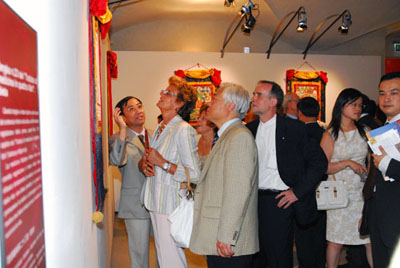| BEIJING - More than 50 Beijing-based correspondents for more than 30 overseas media organizations visited on Wednesday an exhibition marking the 50th Anniversary of Democratic Reforms in Tibet.
Alain Arnaud, Radio Suisse Romande, arrived in China just two weeks ago. He told Xinhua that Western media do not know enough about China and he came to learn more about the real situation in China and the lives of ordinary Chinese.

Talking about the exhibition, he said: "I want to know what China says about Tibet and I also want to know in what way the Chinese government helped the people in Tibet."
"I saw a lot of original documents, which I never saw before, about slavery in Tibet. It is quite impressive ... This is not the image we show in the West when we talk about Tibet," he added.
The exhibition, which opened February 24, has five sections: the Peaceful Liberation of Tibet, Crackdown on the Armed Rebellion, Democratic Reform in Tibet, Half a Century of Conflict between Reunification and Separation, Progress and Regress, and Social and Economic Development and Achievements in Human Rights.
More than 500 photos, more than 180 objects and documents and many audio-visual materials present the great changes that have taken place in Tibet over the past 50 years.
Sergi Vicente, Beijing correspondent from Televisio de Catalunya, has been to Tibet and Qinghai. He believed that great progress has been made in Tibet and the Chinese government "has invested a lot and tried to make people happy."
"Many people in the West have never been to Tibet but they say things such as, that Tibetan culture is disappearing or the Tibetan language is forbidden. I am disappointed about this kind of ignorance," he said.
Two researchers from the China Tibetology Research Center answered the questions of foreign journalists.
"It is a good approach to know more about Tibet and its development in last 50 years," said John Bailey, a correspondent for the South African Broadcasting Corp. (SABC), saying that experts' answers helped a lot "to understand the history of Tibet".
The exhibition in the Cultural Palace of Nationalities runs until April 10. It is co-sponsored by the Information Office of the State Council, the United Front Department of the Communist Party of China Central Committee, the State Ethnic Affairs Commission, the Tibet Autonomous Region, the Central Archives, and Xinhua News Agency. |



